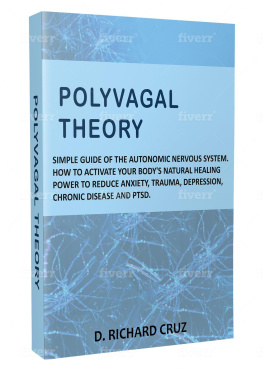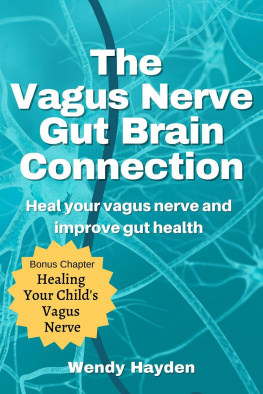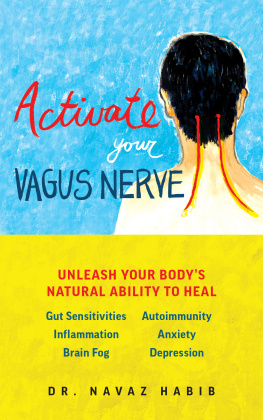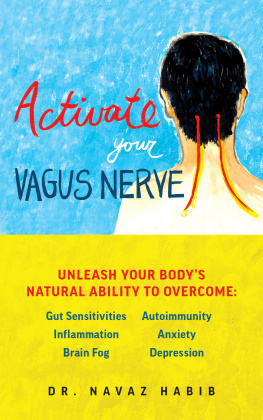VAGUS NERVE
Legal Notice
Copyright (c) 2020 Caroline Robertson.
All rights are reserved. No portion of this book may be reproduced or duplicated using any form whether mechanical, electronic, or otherwise. No portion of this book may be transmitted, stored in a retrieval database, or otherwise made available in any manner whether public or private unless specific permission is granted by the publisher.
This book does not offer advice, but merely provides information. The author offers no advice whether medical, financial, legal, or otherwise, nor does the author encourage any person to pursue any specific course of action discussed in this book. This book is not a substitute for professional advice. The reader accepts complete and sole responsibility for the manner in which this book and its contents are used. The publisher and the author will not be held liable for any damages caused.
Vagus Nerve
Activate the Healing Power of Your Vagus Nerve and Unlock Powerful Natural Relief for Anxiety, Depression, and Chronic Illness
Caroline Robertson
Contents
Despite Darwinists insisting on the bodys poor design, there is no question how wonderful a machine the human body is. It consists of organic structures so complex that its the only thing in the world that can do what it can do. And while science has helped reveal to us the potentials of the human body, there are still aspects of it that remain a mystery to us. Even the things it can do that can be explained by science still leave us in awe.
Take the human eye and its ability to perceive its surroundings, for example. All throughout the day we blink every five seconds, and each blink is so fast that it doesnt seem we have actually closed our eyes in those moments. There is something in the brain that allows us to perceive images continuously, even when we are blinking.
And then theres the olfactory system, which allows us to differ one odor from another, even though those odors we smell are collections of different molecules. Its also interesting to note that that function of the sense of smell is not simply to smell but to detect toxins, virus, and bacteria. It also helps judge the nutritional content of foods.
These are just a couple of examples of how remarkable the human body is. And just recently, scientists have been studying a particular organ thats not that well known but what scientists say is the most important nerve in the body. This nerve is called the vagus nerve.
What Is The Vagus Nerve and What Does It Do?
Traditionally referred to as the pneumogastric nerve, the vagus nerve is the longest, and unsurprisingly, the most complex of the twelve cranial nerve pairs emanating from the human brain. The main purpose of this nerve is to pass on information to and from the brains surface to different organs and tissues in the body.
The term vagus is Latin for wandering, and thats just what describes the vagus nerve, which wanders from the brain and onto different organs in the rest of the body, from the neck, chest, and down to the abdomen. Also known as CN X or the tenth cranial nerve, the vagus nerve bonds with the parasympathetic control of the digestive tract, the lungs, and the heart. Normally referred to in the singular, the vagus nerve is the longest of the autonomic nervous system nerves, with its end part known as spinal accessory nucleus.
The vagus nerve consists of two clusters of sensory nerve cell bodies. It connects the brainstem to the rest of the body and allows the brain to receive information regarding several of the bodys functions, as well as monitor those functions.
Vagus Nerve Structure
In terms of structure, the vagus nerve extends through the jugular foramen from the medulla oblongata, passing through the inferior cerebellar peduncle. It then stretches into the carotid sheath between the internal jugular vein and the internal carotid artery, and then down to the abdomen from the chest and the neck. There, the vagus nerve helps supplies nerves to the viscera, which reaches down to the colon.
The vagus nerve also gives output to several organs, as well as comprises up to 90% of afferent nerves that convey sensory information regarding the condition of the different bodily organs to the central nervous system. Descending from the cranial vault are the right and left vagus, which pass through the jugular foramina and penetrates the carotid sheath between the carotid arteries. They then pass the posterolateral artery to the common carotid artery. Meanwhile, the vagus nerves visceral afferent fibers cell bodies are found bilaterally in its inferior ganglion.
The right vagus nerve raises the right recurrent laryngeal nerve hooking around the right subclavian artery. It then ascends to the neck passing between the esophagus and the trachea. The right vagus then crosses precursive to the right subclavian artery and then runs rearward the superior vena cava. It then descends posterior to the right main bronchus and spreads throughout the esophageal plexuses, as well as the cardiac and pulmonary plexuses. It composes the posterior vagal trunk located at the lower part of the esophagus, and then passes through the diaphragm via the esophageal hiatus.
Meanwhile, the left vagus nerve goes through the thorax between the left common carotid artery and the left subclavian artery, descending onto the aortic arch. It raises the left recurrent laryngeal nerve hooking around the aortic arch to the left side of the ligamentum arteriosum, and then ascends between the esophagus and the trachea. The left vagus forms thoracic cardiac branches, which breaks up into pulmonary plexus and continues down to the esophageal plexus. Finally, it enters the abdomen in the esophageal hiatus of the diaphragm as the anterior vagal trunk.
Vagus Nerve Function
There are two components to the sensory functions of the vagus nerve, and these are the somatic components and the visceral components. Somatic components refer to the sensations felt on the skin and muscles. These sensations are brought about by the auricular nerve, which innervates the skin of the rear part of the external ear and the external auditory canal. Visceral components, on the other hand, refer to the sensations felt in the different organs of the body. The laryngopharynx, for instance, is innervated by the vagus nerve through the internal laryngeal nerve, while the superior aspect of the larynx above the vocal folds are innervated via the internal laryngeal nerve. The heart, on the other hand, is innervated through the branches of the vagus nerve, and the gastro-intestinal tract including the splenic flexure, via the vagus nerves terminal branches.
One of the special roles the vagus nerve plays is in taste sensation. The nerve carries afferent fibers from the base of the tongue and the epiglottis. Other sensory functions of the nerve include the provision of somatic sensation information for the skin located behind the ear, the external region of the ear canal, and some parts of the throat, as well as supplying visceral sensation information for the lungs, trachea, larynx, esophagus, and most of the digestive tract.
In terms of the motor functions, the vagus nerve innervates much of the muscles associated with the larynx and pharynx. Both these muscles are responsible for phonation and swallowing. In the pharynx, most of the muscles in the region are innervated by the vagus nerve via the pharyngeal branches. These include the superior, inferior, and middle pharyngeal constrictor muscles, the palatopharyngeus, and the salpingopharyngeus. The stylopharyngeus, which is an additional muscle of the pharynx, is innervated via the glossopharyngeal nerve.
Meanwhile, the intrinsic muscles of the larynx are innervated by the superior laryngeal nerves external branch (cricothyroid) and the recurrent laryngeal nerve (thyro-arytenoid, posterior crico-arytenoid, lateral crico-arytenoid, vocalis, and transverse and oblique arytenoids).









